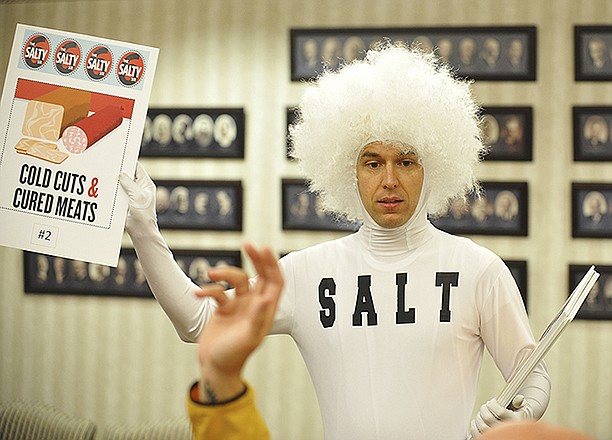Some of the worst health risk factors can really sneak up on you - and so can the things that cause them.
That was the idea behind the American Heart Association's "Sneaky Salt" tour of Jefferson City Wednesday.
"We're trying to get our community to be more mindful of their sodium intake - and maybe not put that extra salt on their mashed potatoes," said Kelly Trigg, corporate events director for the Midwest affiliate of the American Heart Association (AHA).
Sneaky Salt - otherwise known as Stephen Hall, senior communications director for AHA in Springfield, dressed in a white body suit and wig - crept around the streets of Jefferson City and to 10-15 different businesses educating people about the dangers of hidden sodium in everyday foods.
"The good of sodium is it's a mineral. We have to have it for our bodies to actually function. ... But we are all probably getting way too much of it," Trigg said. "If you get too much, you might start getting higher blood pressure."
High blood pressure can contribute to stroke, a special concern of AHA during May, which the organization designates as American Stroke Month.
While the U.S. Food and Drug Administration caps a person's recommended daily sodium intake at 2,400 milligrams, AHA suggests no more than 1,500 milligrams per day.
As Sneaky Salt, Hall spread the word on just how much sodium might be concealed in common foods - like bread and rolls, which might contain 250 milligrams per serving, or pizza, which contains on average 750 milligrams of sodium for one slice with two toppings.
"If you're at a restaurant and they don't have it disclosed on the menu, a lot of Americans don't know what they're taking in," Hall said, addressing the members of AHA's Heart Walk committee during a surprise visit to their meeting. "The American Heart Association advocates for full disclosure on restaurant menus because we want consumers to be able to know what they're eating."
The amount of sodium in any food depends on who produces it and how it is prepared, he continued. An average serving of poultry contains around 400 milligrams of sodium. A can of soup typically contains between 840-940 milligrams.
A 2-ounce (or six-slice) serving of cold cuts or cured meats can pack up to 750 milligrams of sodium. Add two slices of bread to make a sandwich, and that meal could reach 1,500 milligrams of sodium - AHA's recommended daily limit.
At each business Sneaky Salt visited yesterday and throughout the streets of Jefferson City, AHA representatives encouraged people to sign pledges to be more mindful of their sodium intake. Their goal was to collect 500 pledges in Jefferson City, and they had already collected about 250 by the time of the Heart Walk committee's noon meeting.

